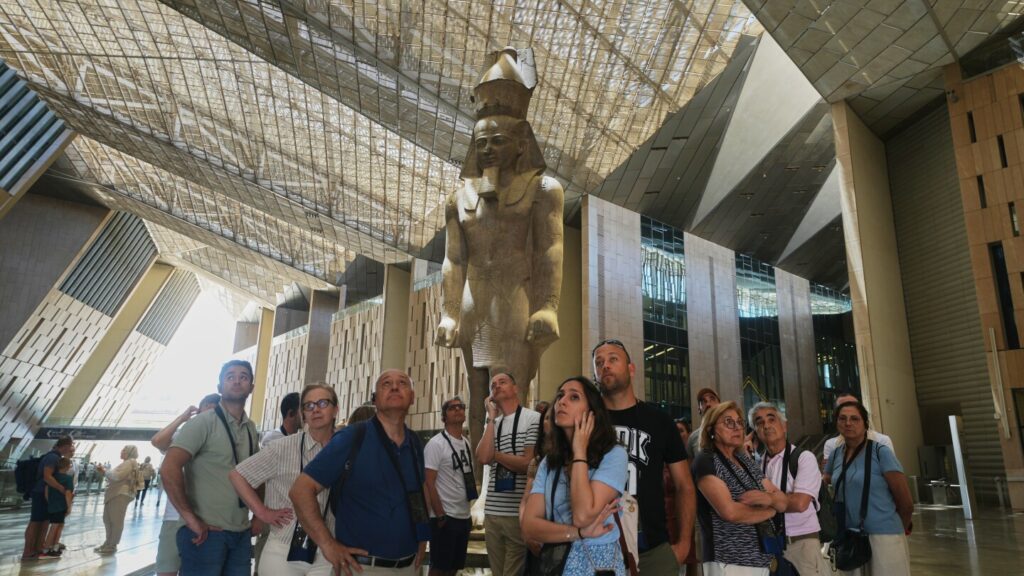CAIRO (AP) – After 20 years of anticipation and countless delays, the Grand Egyptian Museum is finally opening its doors to the public.
The museum, which is scheduled to officially open on Saturday, focuses on Egypt’s ancient civilization and is at the heart of the government’s efforts to revitalize cash-strapped Egypt’s tourism industry, its main source of foreign currency.
Located on the outskirts of Cairo next to the famous Giza Pyramids, this $1 billion mega-facility is poised to become the world’s largest museum dedicated to a single civilization, with more than 50,000 artifacts detailing life in ancient Egypt. By comparison, the Louvre in Paris has about 35,000 pieces on display.
The museum is one of the mega-projects of President Abdel Fattah el-Sissi. Since taking office in 2014, the president has embarked on a massive investment in infrastructure aimed at rebuilding an economy weakened by decades of stagnation and battered by unrest following the 2011 Arab Spring uprisings.
Construction of the museum began in 2005, but work was halted for three years during the political turmoil that followed the 2011 uprising.
The grand opening has been postponed multiple times, most recently to July of this year due to the conflict in the Middle East. World leaders are expected to attend Saturday’s opening ceremony.
Huge building overlooking the Pyramids of Giza
Designed by Irish firm Heneghan Penn Architects, the museum is known as GEM and boasts a towering triangular glass façade that mimics the nearby pyramids.
In its entrance atrium stands a colossal granite statue of Ramesses the Great, one of Egypt’s most famous pharaohs. The 3,200-year-old statue, 11 meters high, sat in the middle of a traffic-choked roundabout in front of Cairo Central Station for decades before being moved to a museum.
From the atrium, a grand six-story staircase lined with ancient statues leads to the main gallery with views of the nearby pyramids. Museum officials say the museum and the pyramids are connected by a bridge, allowing visitors to travel between the pyramids on foot or by eco-friendly electric vehicles.
The museum includes 24,000 square meters (258,000 square feet) of permanent exhibition space, a children’s museum, conference and education facilities, commercial areas, and an extensive preservation center.
The 12 main galleries, which opened last year, display antiques organized by period and theme, from prehistoric times to Roman times.
Many of GEM’s 50,000 artifacts were moved from the Egyptian Museum, a crowded 100-year-old building in downtown Cairo’s Tahrir Square. Others have recently been unearthed from ancient necropolises, including the necropolis of Saqqara, another pyramid and tomb complex about 14 miles south of the museum.
The museum’s CEO, Ahmed Ghoneim, said the hall is equipped with advanced technology and features multimedia presentations such as mixed reality shows that help explain ancient Egypt to new generations.
“We’re using the language that Gen Z is using now,” he said in an interview. “Gen Z no longer uses the labels we read as old people, but rather uses technology.”
Tutankhamun’s collection comes together for the first time
Saturday’s grand opening will include the dedication of two halls displaying 5,000 artifacts from King Tutankhamun’s collection.
This is the first time the entire collection has been exhibited since British archaeologist Howard Carter discovered King Tut’s tomb in the southern city of Luxor in 1922. The Old Egyptian Museum did not have enough space to display all the tomb’s treasures at once.
Several masterpieces have been restored at the museum’s conservation center, including the boy pharaoh’s three funerary beds and six chariots, said Jaylan Mohamed, the center’s chief conservator.
They will be displayed alongside his golden throne, gold-encrusted sarcophagus and burial mask made of gold, quartzite, lapis lazuli and colored glass. The mask’s beard accidentally fell off in 2014 and was hastily reattached with epoxy, but was repaired the following year by a team of German and Egyptian experts.
Another highlight of the museum is the 4,600-year-old solar ship of Pharaoh Khufu, who is credited with building the Great Pyramids of Giza. Discovered in the 1950s, the 43-meter-long (140-foot) wooden ship was buried next to the Great Pyramid by King Khufu (also known as Khufu) for use in the afterlife. In 2021, it was moved from its exhibition location near the pyramids to the Grand Egyptian Museum in a remote-controlled vehicle imported from Belgium.
Government hopes museums will boost tourism
The government hopes the museum will attract more tourists, who will stay for a while and provide the foreign exchange needed to strengthen Egypt’s economy.
The tourism industry had suffered from years of political turmoil and violence following the 2011 Arab Spring uprisings. In recent years, the sector has begun to recover from the impact of the coronavirus pandemic and Russia’s war against Ukraine. Russia and Ukraine are both major sources of tourists visiting Egypt.
A record 15.7 million people will visit the country in 2024, according to official figures, and the government aims to attract 30 million tourists by 2032.
Authorities thoroughly inspected the museum and the entire area around the pyramid. To facilitate access to the site, roads are being paved and a metro station is being built outside the museum gates. An airport, Sphinx International Airport, has also opened to the west of Cairo, 40 minutes from the museum.
Hassan Alam, CEO of Hassan Alam Holding, which operates the museum, said the museum is expected to receive between 15,000 and 20,000 visitors per day.
“It’s what the world has been waiting for…everyone is excited,” he said.

